Tuwa |
|
|
|
| Übersicht – Contents: | |
Tuwa |
|
|
|
| Übersicht – Contents: | |
Flagge – Flag: |
|
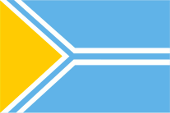 |
Nationalflagge – national flag, |
historische Flaggen – historical Flags: |
|
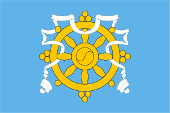 |
1914–1921, |
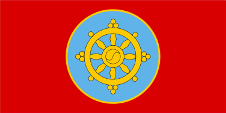 |
1921–1926, |
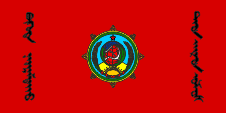 |
1926–1930, Flagge der Volksrepublik Tannu-Tuwa – flag of the People's Republic of Tannu-Tuva, Seitenverhältnis – ratio = 1:2, Quelle/Source, nach/by: Lumia1234, Public domain, via Wikimedia Commons |
 |
1930–1935, Flagge der Volksrepublik Tannu-Tuwa – flag of the People's Republic of Tannu-Tuva, Seitenverhältnis – ratio = 1:2, Quelle/Source: Lumia1234, Public domain, via Wikimedia Commons |
 |
1935–1941, Flagge der Volksrepublik Tannu-Tuwa – flag of the People's Republic of Tannu-Tuva, Seitenverhältnis – ratio = 1:2, Quelle/Source: Lumia1234, Public domain, via Wikimedia Commons |
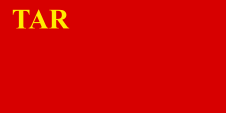 |
1941–1943, Flagge der Volksrepublik Tannu-Tuwa – flag of the People's Republic of Tannu-Tuva, Seitenverhältnis – ratio = 1:2, Quelle/Source, nach/by: World Statesmen |
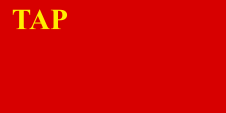 |
1943–1944, Flagge der Volksrepublik Tannu-Tuwa – flag of the People's Republic of Tannu-Tuva, Seitenverhältnis – ratio = 1:2, Quelle/Source, nach/by: World Statesmen |
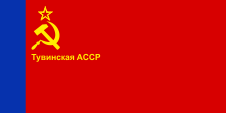 |
1962–1971, Flagge der Tuwinischen Autonomen Sozialistischen Sowjetrepublik – flag of the Tuvan Autonomous Soviet Socialist Republic, Seitenverhältnis – ratio = 1:2, Quelle/Source, nach/by: World Statesmen |
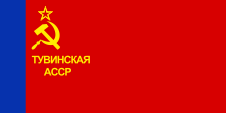 |
1971–1978, Flagge der Tuwinischen Autonomen Sozialistischen Sowjetrepublik – flag of the Tuvan Autonomous Soviet Socialist Republic, Seitenverhältnis – ratio = 1:2, Quelle/Source, nach/by: World Statesmen |
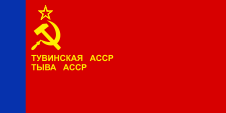 |
1978–1992, Flagge der Tuwinischen Autonomen Sozialistischen Sowjetrepublik – flag of the Tuvan Autonomous Soviet Socialist Republic, Seitenverhältnis – ratio = 1:2, Quelle/Source, nach/by: World Statesmen |
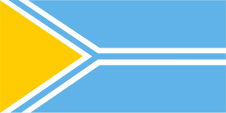 |
1992–2002, |
|
siehe auch – look also: Flaggengeschichte der Sowjetrepubliken der UdSSR – flag history of the soviet republics of the USSR |
|
Bedeutung/Ursprung der Flagge – Meaning/Origin of the Flag: |
|
|
Die heutige Flagge von
Tuwa wurde am 17.09. oder 18.09.1992 eingeführt. Sie zeigt ein hellblaues
Grundtuch und ein gelbes gleichschenkliges Dreieck am Mast. Das Dreieck wird
eingefasst durch ein hellblaues, weiß umrandetes Ypsilon, dass sich über die
Mitte der Flagge bis zum wehenden Ende fortsetzt. Die Farben der Flagge
sollen wahrscheinlich an die ersten Flagge von Tuwa erinnern, als das Land
mit Unterstützung Russlands im Jahre 1914 die Unabhängigkeit von China
erreichte. Gelb steht für Wohlstand und ist die Farbe des Buddhismus, Blau
steht für Mut und Kraft und für den Himmel und ist die Farbe der Turkvölker,
Tataren und Mongolen, Weiß steht für Silber, Tugend und Reinheit. Das
Ypsilon symbolisiert den Zusammenfluss von Großem und Kleinem Jenissei nahe
der Hauptstadt Kysyl. Am 08.02.2002 wurde das Format der Flagge von 1:2
(früher in der Sowjetunion üblich) auf 2:3 abgeändert. Die Farbtöne der Farben der Flagge scheinen definiert zu sein, zumindest lassen sich folgende HEX-Farbangaben finden, aus denen sich Pantone-Farbtöne ableiten lassen: Hellblau #63B3E6 = Pantone 2915 C, Gelb #FECC00 = Pantone 123 C. In der Praxis sind aber auch Flaggen zu sehen, die ein dunkleres Blau zeigen. Kurz nach Erlangen der Unabgängigkeit von China wurde eine Flagge eingeführt, die ein einfarbiges hellblaues Grundtuch zeigte, darauf ein goldenes Khorlo, das buddhistische Rad der Lehre, welches mit weißen Bändern geschmückt war. Bis zum Jahr 1930 wurde die buddhistische Symbolik Schritt für Schritt von den verwendeten, immer mehr kommunistisches Rot zeigenden Flaggen verdrängt. Ab 1930 war nur noch kommunistische Symbolik zu sehen, und ab 1941 sogar nur noch die Initialen des Landes als drei goldene Buchstaben im Obereck einer roten Flagge. Die Flaggen, die zu Sowjet-Zeiten verwendet wurden, entsprachen alle dem immer gleichen Schema, wie es für Sowjetische Republiken vorgesehen war: oft nur ein einfabiges rotes Flaggentuch mit einer goldenen Inschrift, die den Landesnamen zeigte. Manchmal nur als Abkürzung, manchmal mit vollem Namen, manchmal nur in Russisch oder auch mehrsprachig. Ab etwa 1937 wurden manchmal noch Hammer, Sichel und Stern ergänzt. Ab etwa der Mitte der 50-er Jahre wurden mehrfarbige Flaggen für die Republiken der Sowjetunion eingeführt, deren Strickmuster die untergeordneten Autonomen Sowjetrepubliken zu übernehmen hatten. Für Tuwa hieß das, dass es sich an der Flagge der Russischen Föderativen Sowjetrepublik (Sowjetrussland) zu orientieren hatte. |
The current flag of Tuva
was introduced on 17th or 18th of September in 1992. It shows a light blue
bunting and a yellow isosceles triangle on the mast. The triangle is framed
by a light blue ypsilon with a white border, which continues across the
centre of the flag to the waving end. The colours of the flag are probably intended to recall the first flag of Tuva, when the country achieved independence from China with the support of Russia in 1914. Yellow stands for prosperity and is the colour of Buddhism, blue stands for courage and strength and for the sky and is the colour of the Turkic peoples, Tatars and Mongols, white stands for silver, virtue and purity. The ypsilon symbolises the confluence of the Great and Little Yenisei near the capital Kysyl. On 8th of February in 2002, the aspect ratio of the flag was changed from 1:2 (previously common in the Soviet Union) to 2:3. The shades of the colours of the flag seem to be defined, at least the following HEX colour specifications can be found, from which Pantone colour shades can be derived: Light blue #63B3E6 = Pantone 2915 C, Yellow #FECC00 = Pantone 123 C. In practice, however, flags showing a darker blue can also be seen. Shortly after gaining independence from China, a flag was introduced that showed a single-coloured light blue bunting with a golden khorlo, the Buddhist wheel of doctrine, decorated with white ribbons. By 1930, the Buddhist symbolism was gradually replaced by the flags used, which increasingly showed communist red. From 1930 onwards, only communist symbolism could be seen, and from 1941 only the initials of the country as three golden letters in the upper corner of a red flag. The flags, which were used in the Soviet era corresponded all to the same pattern as it was intended for the Soviet Republics: frequently only a single-coloured red bunting with a golden inscription, showing the name of the country. Sometimes only as a shortcut, sometimes the full name, sometimes only in Russian or even multilingual. From about 1937 hammer, sickle and star were sometimes added. From about the mid-50s multicolored flags were introduced for the republics of the Soviet Union, whose knitting patterns had to be taken over by the subordinated autonomous Soviet republics. For Tuva, this meant that it had to orientate itself on the flag of the Russian Soviet Federative Republic (Soviet Russia). |
| Quelle/Source, nach/by: Flaggen Enzyklopädie, 1.) Wikipedia (EN), 2.) Wikipedia (EN), Volker Preuß | |
Wappen – Coat of Arms: |
|
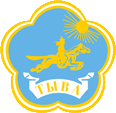 |
Wappen der Republik Tuwa – coat of arms of the Republic of Tuva, Quelle/Source: Wikipedia (RU) |
Bedeutung/Ursprung des Wappens – Meaning/Origin of the Coat of Arms: |
|
| Das heutige Wappen von Tuwa wurde am 17.09.1992 angenommen. Die Form des Wappens ist ein stilisiertes Bild, das die Vorstellungen der alten Turkvölker über den Aufbau der Welt darstellt. In der Mitte ein tuwinischer Reiter, der der Sonne entgegenreitet. Er steht für die traditionelle Lebensweise und die grundlegende wirtschaftliche Tätigkeit der Einwohner. Die Sonne steht für den Wunsch der Tuwiner nach hohen Idealen, Frieden und Wohlergehen. Das Spruchband, das den Staatsnamen in kyrillischen Buchstaben in Gold trägt, ist ein "Kadak", ein ritueller langer Schal, das die Gastfreundschaft und Freundlichkeit der Menschen der Republik Tuwa widerspiegelt. Die Farben haben auch ihre Bedeutung: Blau symbolisiert klaren Himmel, hohe Ziele, gegenseitigen Respekt und Harmonie in der Gesellschaft und es ist die Farbe der Turkvölker, Tataren und Mongolen. Weiß steht für Reinheit, Tugend, Offenheit und Unabhängigkeit. Gelb (Gold) steht für Wohlstand und ist die Farbe des Buddhismus. Ein ähnliches Wappen war, ergänzt um kommunistische Symbole, bereits zwischen den Jahren 1933 und 1941 in Verwendung und auch die benachbarte Mongolei verwendet ein ähnliches Bild im Wappen. |
The current coat of arms
of Tuva was adopted on 17th of September in 1992. The shape of the coat of arms is a stylised image representing the ideas of the ancient Turkic peoples about the structure of the world. In the centre is a Tuvan horseman riding towards the sun. It symbolises the traditional way of life and the basic economic activity of the inhabitants. The sun symbolises the Tuvans' desire for high ideals, peace and prosperity. The banner bearing the name of the state in Cyrillic letters in gold is a "kadak", a ritual long scarf that reflects the hospitality and friendliness of the people of the Republic of Tuva. The colours also have their meaning: blue symbolises clear skies, high goals, mutual respect and harmony in society and it is the colour of the Turkic peoples, Tatars and Mongols. White symbolises purity, virtue, openness and independence. Yellow (gold) stands for prosperity and is the colour of Buddhism. A similar coat of arms, supplemented by communist symbols, was already in use between 1933 and 1941 and neighbouring Mongolia also uses a similar image in its coat of arms. |
| Quelle/Source, nach/by: Wikipedia (EN), Wikipedia (RU), Volker Preuß | |
Landkarten – Maps: |
geographische Lage in Russland – geographical position within Russia: |
Landkarte des Landes – map of the country: |
Zahlen und Fakten – Numbers and Facts: |
|
|
|
|
|
|
|
|
|
|
|
|
|
|
|
|
|
|
|
|
Geschichte: |
|
Antike
· Herausbildung des Tuwinischen Volkes aus skythischen, mongolischen und
türkischen Stämmen 1207 · Eroberung durch die Mongolen unter Dschingis Khan 1227 · Tod des Dschingis Khan, Aufteilung des Reiches unter seinen vier Söhnen, sein Sohn Ügedei erhielt das heutige China, Korea, die heutige Mongolei, Tuwa und Mandschurei und wurde zum Nachfolger und Großkhans ernannt, sein Sohn Kublai Khan bedründete die Chinesische Yuan-Dynastie 14.–15. Jahrhundert · China verliert die Kontrolle über Tuwa, Herrschaft von Uiguren, Kirgisen, Oiraten und Mongolen 1696 · die chinesische Mandschu-Dynastie erobert die Gebiete der Mongolen, und damit auch Tuwa, Tuwa wird Provinz Tannu-Urjanchai 10.10.1911 · Sturz der Monarchie in China, Unruhen, separatistische Bestrebungen Oktober bis Dezember 1912 · Unabhängigkeit für Tibet, Ostturkestan (Dschungarei) und die Äußere Mongolei (einschließlich der Provinz Tannu-Urjanchai) 1912 · Abspaltung (unterstützt von Russland) von Tannu-Urjanchai von China, Staat Tannu-Tuwa 1914 · Tannu-Tuwa wird russisches Protektorat (Protektorat Urjanchai-Region), ein späterer Vertrag zwischen Russland und China gewährt Tannu-Tuwa die Unabhängigkeit unter nomineller chinesischer Oberhoheit 1917 · Leninputsch in Russland, Tannu-Tuwa erklärt erneut seine Unabhängigkeit 1917–1921 · Bürgerkrieg in Tannu-Tuwa, Sieg der russischen Bolschewisten 14.08.1921 · Proklamation der Volksrepublik Tannu-Tuwa als Satellitenstaat Sowjetrusslands 1925 · Kuular Donduk wird Präsident des Landes, Buddhismus wird Staatsreligion 1926 · Garantievertrag zwischen der Sowjetunion, der Mongolei und Tannu-Tuwa Januar 1929 · Kuular Donduk wird auf Befehl Stalins ermordet 1930 · Einführung der lateinischen Schrift 1940 · Einführung der kyrillischen Schrift 1930–1944 · Kollektivierung, Sowjetisierung, Verdrängung von Buddhismus und Schamanismus 11.10.1944 · Tannu-Tuwa beantragt die Aufnahme in die Sowjetunion, Tannu-Tuwa wird Autonomes Gebiet innerhalb Sowjetrusslands 10.10.1961 · das Tuwinische Autonome Gebiet wird Autonome Sozialistische Sowjetrepublik innerhalb Sowjetrusslands November 1991 · Tuwa proklamiert seine Unabhängigkeit 31.12.1991 · die Sowjetunion löst sich auf, die Verfassung der Russischen Sozialistischen Föderativen Sowjetrepublik (RSFSR, Russland), ein ehemaliger Teilstaat der Sowjetunion bleibt vorerst in Kraft 25.12.1993 · eine neue Verfassung für Russland (Russische Föderation) tritt in Kraft, das Verhältnis zu den Gliedern der Föderation wird damit neu geregelt |
History: |
|
Antiquity
· evolution of the Tuvin nation from Scythic, Mongol and Turk tribes 1207 · conquest by the Mongols under Dshingis Khan 1227 · death of Dshingis Khan, partition of his empire under his four sons, Uegedei got the today’s China, Korea and the today’s Mongolia and Mandshuria and he became nominated to successor and Grand Khan, his son Kublai Khan established the Yuan dynasty 14th–15th century · China loses control over Tuva, rule of Uigurs, Kirghiz, Oirats and Mongols 1696 · the Chinese Manchu dynasty conquers the territories of the Mongols, and in this way also Tuva, Tuva becomes the Province of Tannu-Uryankhay 10th of October 1911 · overthrow of the monarchy in China, agitations, separatist ambitions October to December 1912 · independence for Tibet, East Turkestan (Dsungaria) and the Outer Mongolia (including the Province of Tannu-Uriankhai) 1912 · separation (supported by Russia) of Tannu-Uriankhai from China, State of Tannu-Tuva 1914 · Tannu-Tuva becomes a Russian protectorate (Protectorate of Uryankhay Region), a later treaty between Russia and China grants Tannu-Tuva the independence under nominal Chinese supremacy 1917 · Lenin revolt in Russia, Tannu-Tuva declares once more its independence 1917–1921 · civil war in Tannu-Tuva, victory of the Russian bolshevists 14th of August 1921 · proclamation of the People’s Republic of Tannu-Tuva as a satellite state of Soviet Russia 1925 · Kuular Donduk becomes president of the country, the Buddhism becomes state religion 1926 · guaranty treaty between Soviet Union, Mongolia and Tannu-Tuva January 1929 · assassination of Kuular Donduk by order of Stalin 1930 · introduction of the Latin alphabet 1940 · introduction of the cyrillic alphabet 1930–1944 · collectivation, sovietization, ousting of Buddhism and ancient religions 11th of October 1944 · Tannu-Tuva proposes the annexation to the Soviet Union, Tannu-Tuva becomes an autonomous territory within Soviet Russia 10th of October 1961 · the Tuvin Autonomous Territory becomes an autonomous socialistic soviet republic within Soviet Russia November 1991 · Tuva proclaims its independence 31st of December in 1991 · the Soviet Union dissolves, the constitution of the Russian Socialist Federative Soviet Republic (RSFSR, Russia), a former substate of the Soviet Union, remains in force for the time being 25th of December in 1993 · a new constitution for Russia (Russian Federation) comes into force, and the relationships with the members of the federation is re-regulated in this way |
| Quelle/Source: Atlas zur Geschichte, World Statesmen, Russiatrek, Die Völker der Erde, Wikipedia (D) |
Ursprung des Landesnamens – Origin of the Country's Name: |
|
| Der Name "Tuwa" ist russischen Ursprungs und bezieht sich auf die Tuwiner, das hier lebende Turkvolk. Die Tuwiner nennen sich selbst "Tywa-Kischi" und ihr Land "Tywa". Ältere Bezeichnungen für die Tuwiner sind: "Sojonen" und "Urjanchai". | The name
"Tuva" is of Russian origin and has its roots in the Tuvins, the here living
Turk nation. The Tuvins call themselves "Tyva-Kishi" und their country "Tyva". Older denominations for the Tuvins are: "Soyons" and "Uryankhay". |
| Der Name "Tannu-Tuwa" meint "Land der Tuwiner im Tannu-Ola-Gebirge", denn weitere Tuwiner leben in der Mongolei, in Russland, in China und im Hochaltai. | The name "Tannu-Tuva" means "Land of the Tuvins in the Tannu-Ola Mountains", because further Tuvins live in Mongolia, in Russia, in China and in Upper Altay. |
| Quelle/Source: Die Völker der Erde, Volker Preuß | |